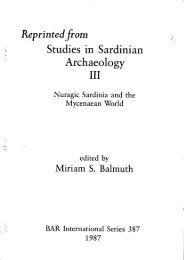The Island of Capri in the Gulf of - Claudio Giardino
The Island of Capri in the Gulf of - Claudio Giardino
The Island of Capri in the Gulf of - Claudio Giardino
You also want an ePaper? Increase the reach of your titles
YUMPU automatically turns print PDFs into web optimized ePapers that Google loves.
Papnns rN IrernN AncHeBorocv VI<br />
r<br />
il<br />
t<br />
r<br />
flGS @\ w 3<br />
lü cm<br />
rïï 1 . .;. í<br />
/. ,,,,,,,,/<br />
6<br />
Fig. 4. I. Tragara; 2. Grotta delle Felci; 3. Il Limmo; 4-<br />
5. Grotta del Pisco; 6. Riparo Kromberger.<br />
628<br />
<strong>The</strong> obsidian fìnds from several places <strong>of</strong> <strong>the</strong> island<br />
probably should be ascribed to <strong>the</strong> Neolithic. Obsidian -<br />
blades and cores - aÍe attested, at <strong>the</strong> Grotta delle Felci,<br />
at Campetiello, at Calcara,e at Hotel Cesare Augusto, at Il<br />
Capo ('Over Tiberius') and at Le Parate; approximately<br />
one thousand tools \ryere discovered <strong>in</strong> <strong>the</strong> past from this<br />
last site.l0 Stone axes were collected <strong>in</strong> <strong>the</strong> past <strong>in</strong> many<br />
localities: at Petrara on <strong>the</strong> western slopes <strong>of</strong> <strong>the</strong> hill <strong>of</strong><br />
Castiglione and at Mongiard<strong>in</strong>o, near Tragara (Fig. 4: I);<br />
<strong>of</strong> some o<strong>the</strong>r axes it is unknown were <strong>the</strong>y come from.ll<br />
<strong>The</strong> transition period between <strong>the</strong> Late Neolithic and <strong>the</strong><br />
first age <strong>of</strong> <strong>the</strong> metals <strong>in</strong> Italy is traditionally placed at <strong>the</strong><br />
beg<strong>in</strong>n<strong>in</strong>g <strong>of</strong> <strong>the</strong> second half <strong>of</strong> <strong>the</strong> 3rd millennium BC.<br />
Some potsherds are attributable to an horizon that is<br />
contemporary <strong>of</strong> <strong>the</strong> Aeolian facies <strong>of</strong> Piano Conte; <strong>the</strong>y<br />
were found at <strong>the</strong> Grotta delle Felcí (Fig. 5: I).<br />
<strong>The</strong> Gaudo culture characterizes late Copper Age <strong>in</strong><br />
Campania. Some potsherds <strong>of</strong> scaled impasto ware and<br />
few o<strong>the</strong>r fragments testiff this chronological horizon at<br />
<strong>Capri</strong>, from <strong>the</strong> Grotta delle Felci (Fig. 5:2).12 From <strong>the</strong><br />
cave some lithic f<strong>in</strong>ds are also generically attributable to<br />
<strong>the</strong> Copper Age: a fragmentary battleaxe <strong>in</strong> grey stone<br />
and one barbed and tanged arrowhead <strong>in</strong> yellowish fl<strong>in</strong>t.<br />
Some fragments <strong>of</strong> impasto ware from <strong>the</strong> Grotta del<br />
Pisco (Anacapri) belong to <strong>the</strong> Copper Age too (Fig. 4:4-<br />
5); this cave is <strong>in</strong> <strong>the</strong> southwestern side <strong>of</strong> <strong>the</strong> island.l3<br />
Tne BnoNzB AcB AND THE Eenrv InoN AcB<br />
is a<br />
period <strong>of</strong> particular prosperity for <strong>the</strong> island <strong>of</strong> <strong>the</strong> <strong>Gulf</strong><br />
<strong>of</strong> Naples. In this period <strong>the</strong> <strong>Gulf</strong> became a strategic<br />
centre <strong>in</strong> <strong>the</strong> transmar<strong>in</strong>e routes from <strong>the</strong> Aegean towards<br />
<strong>the</strong> metal ore deposits <strong>of</strong> nor<strong>the</strong>rn Tyrrhenian ltaty,<br />
Tuscany and Sard<strong>in</strong>ia.<br />
<strong>The</strong> Bronze Age - especially Middle Bronze Age -<br />
A flanged axe from an unknown cave under Monte<br />
Solaro can be ascribed to an archaic moment <strong>of</strong> <strong>the</strong> Early<br />
Bronze Ag".to A fragment <strong>of</strong> dagger from <strong>the</strong> Grotta<br />
delle Felci is a slightly later, Early-Middle Bronze Age.15<br />
It can be ascribed to <strong>the</strong> Mercurago type and <strong>the</strong> S.<br />
Ambrogio type (variety C).tu<br />
Most <strong>of</strong> <strong>the</strong> Campania region was ravaged by <strong>the</strong> socalled<br />
Avell<strong>in</strong>o volcanic eruption <strong>of</strong> Somma-Vesuvius at<br />
<strong>the</strong> end <strong>of</strong> <strong>the</strong> Early Bronze Age.<br />
<strong>The</strong> date <strong>of</strong> <strong>the</strong> eruption is still controversial.<br />
Radiocarbon dates from organic samples and soil<br />
fractions calibrated yields two different calendar age<br />
e Douglas 1985,292;Friedlander 1989, 100.<br />
10 Nicolucci 187 4, 5; 187 6a, 7 ; 187 6b, 82-83.<br />
t t Rell<strong>in</strong>i 1923, 312, 3 I 5 ; Douglas I 985, 288-29 I ; Giard<strong>in</strong>o 1998, 7 9.<br />
tt Rell<strong>in</strong>i 1923, 330; Marzocchella I 985, 3 l, 33.<br />
13 Giard<strong>in</strong>o 1998, 80-81.<br />
to Rell<strong>in</strong>i 1923,3s2.<br />
15 Rell<strong>in</strong>i 1923, 35r-352.<br />
16 See Bianco Peroni 1994,44,pI.21:357.



